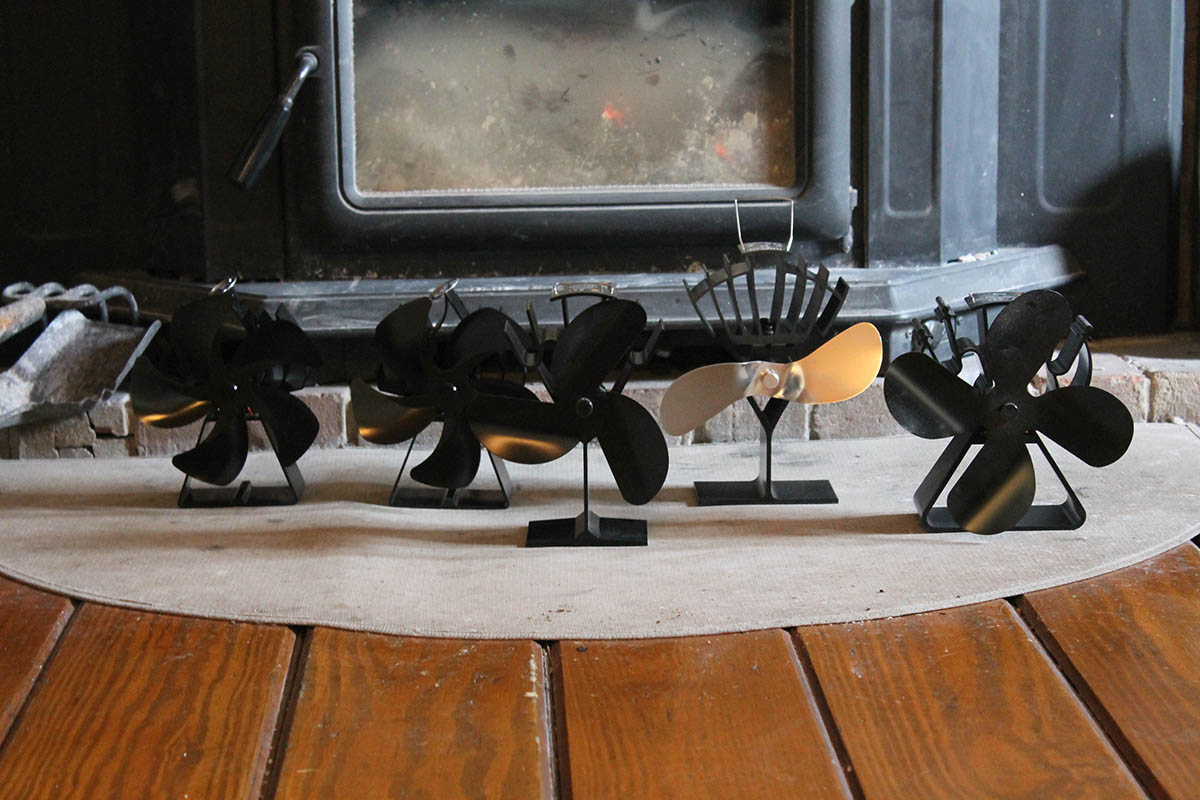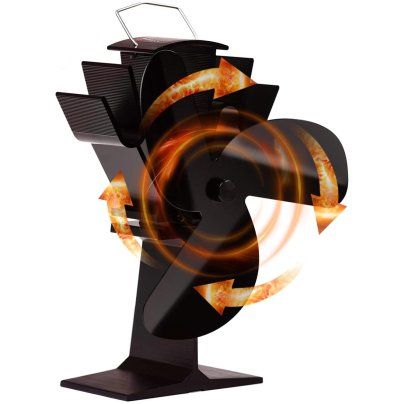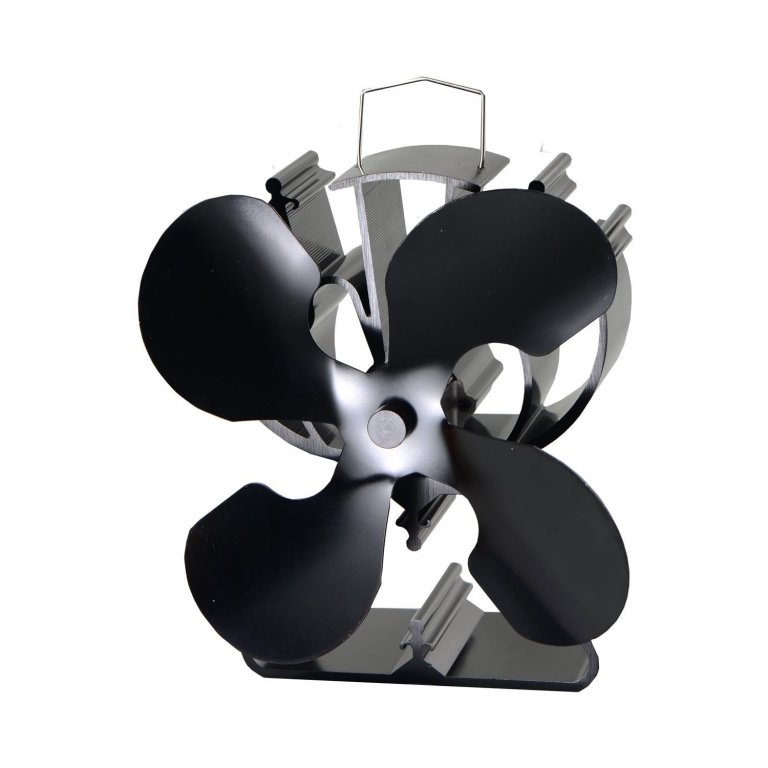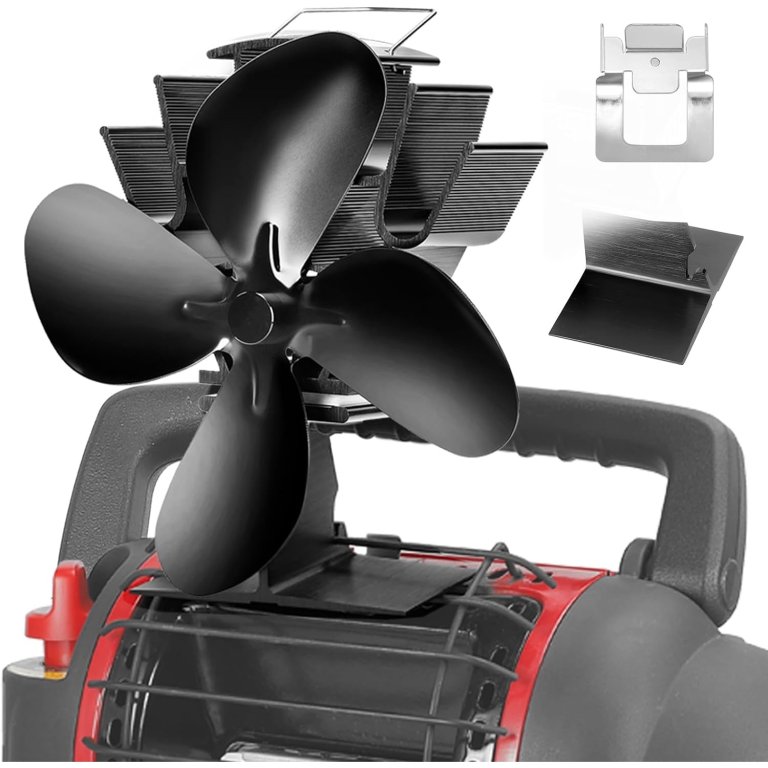
We may earn revenue from the products available on this page and participate in affiliate programs. Learn More ›
A wood stove fan can help distribute the heat from a wood-burning stove, warming a room more efficiently than the stove can unassisted. These little fans typically use the heat generated by the stove to power their motors and don’t require any electricity or batteries to operate. There are numerous wood stove fans available, so to find the cream of the crop, we researched more than 20 models, comparing specs and reviewing dozens of customer reviews. We then tested four standout fans.
After testing, our top pick was the Voda 4-Blade Wood Stove Fan, which quickly spun into action as our stove heated up, providing enough airflow to disperse hot air across the room.
We also enlisted the help of a wood stove and chimney expert, Tim Smith, owner of Albany, New York-based Actual Chimney Specialists. Read on to learn which of the best wood stove fans may be right for your home.
- BEST OVERALL: Voda 4-Blade Wood Stove Fan
↓ Jump to Review - BEST BANG FOR THE BUCK: Tomersun 3-Blade Heat-Powered Wood Stove Fan
↓ Jump to Review - BEST COMPACT: Galafire 4-Blade Heat-Powered Wood Stove Fan
↓ Jump to Review - HONORABLE MENTION: Hanaoyo 6-Blade Wood Stove Fan
↓ Jump to Review

Wood Stove Fans Comparison Chart
| Model | Blades | Operating Temperature | Material | CFM |
| Voda 4-Blade Wood Stove Fan | 4 | 185 to 660 degrees Fahrenheit | Anodized aluminum | 240 |
| Tomersun 3-Blade Heat-Powered Wood Stove Fan | 3 | 176 to 653 degrees Fahrenheit | Anodized aluminum | 170 |
| Ecofan UltrAir Nickel Blade Wood Stove Fan | 2 | 212 to 650 degrees Fahrenheit | Nickel and anodized aluminum | 125 |
| Galafire 4-Blade Heat-Powered Wood Stove Fan | 4 | 122 to 662 degrees Fahrenheit | Anodized aluminum | 126 |
| Hanaoyo 6-Blade Wood Stove Fan | 6 | 131 to 653 degrees | Anodized aluminum | N/A |
Our Top Picks
The products below were tested on a freestanding wood stove and rated based on their performance, durability, and value. Read on to learn how each model fared in our tests and find one right for you.
Best Overall
Voda 4 Blades Wood Stove Fan
See ItWhat We Like
- Available in two finishes
- Quick to power on
- Thermal safety feature protects the fan’s motor
What We Don’t Like
- Doesn’t deliver enough airflow for large spaces
Specs
- Blades: 4
- Operating temperature: 185 to 660 degrees Fahrenheit
- Material: Anodized aluminum
- Cubic feet per minute (CFM): 240
Our Ratings: Performance 4/5; Durability 4.5/5; Value 4/5
Powered entirely by heat, Voda’s four-bladed stove fan is durable and operates silently, making it one of the best ways to circulate air around the wood stove. It kicks on at temperatures as low as 185 degrees Fahrenheit and can withstand temperatures as high as 660 degrees Fahrenheit.
The Voda comes in black and gold finishes to complement different stoves and surroundings. We tested the black version, which was attractive and felt quality-built.
We used a stove thermometer during testing, and the Voda’s blades powered on when our stovetop’s temperature hit the low 100s Fahrenheit. The blades spun quicker as the stove heated up. This fan didn’t produce a lot of airflow, but enough that we could feel it from a few feet away. While it can help distribute air in rooms of all sizes, it’s best equipped to help warm a small room.
Get the Voda wood stove fan at Amazon or Walmart.
Best Bang for the Buck
Tomersun 3 Blades Heat-Powered Wood Stove Fan
See ItWhat We Like
- Budget-friendly price point
- Whisper-quiet noise level
- Compact design fits on smaller wood stoves
What We Don’t Like
- Produces limited airflow
Specs
- Blades: 3
- Operating temperature: 176 to 653 degrees Fahrenheit
- Material: Anodized aluminum
- Cubic feet per minute (CFM): 170
Our Ratings: Performance 3.7/5; Durability 4/5; Value 4/5
With this pick, Tomersun offers an economical way to add a fan to a wood stove. As with other pricier stove fans, this one features whisper-quiet operation and is made from durable anodized aluminum. Its construction looked and felt similar to the other all-aluminum fans we tested, but at a lower cost.
The Tomersun has a built-in safety device that automatically elevates the front of the fan to protect the motor from damage if temperatures exceed 572 degrees Fahrenheit. Its operating range is 176 to 653 degrees Fahrenheit, although the blades began to spin when our stove’s surface temperature reached a little over 100 degrees Fahrenheit.
The Tomersun stove fan produces an airflow of between 150 and 170 CFM, which is adequate for circulating air through small spaces. Like the other fans we tested, we didn’t feel the airflow more than a few feet away from the fan. However, this choice is a good value for those looking for a wood-burning stove fan for a small space.
What our tester says: “I appreciate this fan’s durable construction and attractive price point. It would be ideal for circulating airflow in a small space.” —Katie Barton, Product Reviews tester and writer
Get the Tomersun wood stove fan at Amazon.
More Great Options
The following wood stove fans have garnered hundreds (or thousands) of positive user reviews. Their standout features and high customer satisfaction ratings have earned them a spot on our list.
Best Compact
Galafire 4-Blade Heat-Powered Wood Stove Fan
See ItWhat We Like
- Compact size is ideal for smaller wood stoves
- Starts working at a low temperature
- Features an efficient four-blade design
What We Don’t Like
- May not deliver adequate airflow
Specs
- Blades: 4
- Operating temperature: 122 to 662 degrees Fahrenheit
- Material: Anodized aluminum
- Cubic feet per minute (CFM): 126
This small wood stove fan measures just over 7 inches tall, an ideal choice for more compact wood stoves. Its four-blade design makes it capable of pushing a lot of air. It also starts operating at the low temperature of just 122 degrees Fahrenheit, so it will start circulating air as the stove is just heating up. The Galafire also comes with a thermometer to help monitor the temperature of the wood stove.
Get the Galafire wood stove fan at Amazon.
Honorable Mention
Hanaoyo 6-Blade Wood Stove Fan
See ItWhat We Like
- Features 6 fan blades
- Includes a magnetic stove thermometer
- Quiet operation
What We Don’t Like
- Some user complain about lack of air movement
Specs
- Blades: 6
- Operating temperature: 131 to 653 degrees Fahrenheit
- Material: Anodized aluminum
- Cubic feet per minute (CFM): N/A
This heat-powered stove fan kicks on when temperatures reach as low as 131 degrees Fahrenheit and continues to operate at temperatures as high as 653 degrees Fahrenheit. It’s made from lightweight anodized aluminum and features six blades for maximum airflow.
The Hanaoyo stove fan has built-in thermal protection. If the stove’s surface gets too hot, the base will lift, protecting the fan’s motor. It also comes with a magnetic wood stove thermometer. While many users praise this fan for circulating warm air from their stove, some complain that it’s not powerful enough for large spaces.
Get the Hanaoyo wood stove fan at Amazon.
ALSO TESTED
We also tested the Ecofan UltrAir Nickel Blade Wood Stove Fan. Unfortunately, even though this stove fan was the most expensive and aesthetically pleasing, its two-blade design produced noticeably less circulation than fans with four or five blades. We couldn’t feel any circulation from this fan unless we stood directly in front of it.
Jump to Our Top Picks
How We Chose and Tested the Best Wood Stove Fans
| Testing Stats | |
|---|---|
| Products tested | 4 |
| Time spent testing | 3 weeks |
| Tests performed | 3 |
| Price range | $30 to $100 |
When selecting the best wood stove fans, we considered several factors. Since these fans are exposed to intense heat, we chose models made from durable, heat-resistant materials such as anodized aluminum. Other important features we looked for were safety mechanisms that protect the fan’s motor in case the stove exceeds the fan’s heat rating. Aesthetics were also a factor, given that wood or pellet stove fans are typically clearly visible.
We tested four fans, letting them run on our wood stove for 3 weeks. We evaluated how well each fan could move air through the room from short and long distances. To verify that they worked within their operating temperature range, we monitored our stovetop’s temperature using a wood stove thermometer. We also inspected the construction and let the fans run non-stop for several days to evaluate durability. We used a standardized rubric to award each fan ratings based on performance, durability, and value and tallied those scores at the end of testing to determine which fans were the best.
| Model | Performance | Durability | Value |
| Voda 4-Blade Wood Stove Fan | 4/5 | 4.5/5 | 4/5 |
| Tomersun 3-Blade Heat-Powered Wood Stove Fan | 3.7/5 | 4/5 | 4/5 |
| Ecofan UltrAir Nickel Blade Wood Stove Fan | 3.3/5 | 5/5 | 3/5 |
What to Consider When Choosing a Wood Stove Fan
While performing research, we asked chimney expert Tim Smith of Actual Chimney Specialists a variety of questions to find out what factors are most important when shopping for one of these wood stove accessories. If you’re heating with a wood stove, here’s what you need to know about wood stove fans.
Blades
The number and design of the blades impact how well a wood-burning stove fan can distribute air throughout the room. Typically, fans with four blades do a better job of circulating air than fans with two or three blades.
But while fans with more blades are tempting, Smith points out that fans made with fewer blades and lightweight materials will last longer and spring faster. “A lightweight material such as aluminum would be best so the fan blades will spin quickly without too much stress on the motor,” he says.
The blade design can also play a factor in how effectively the fan moves air. Some wood stove fans utilize curved or angled fan blades to blow air more efficiently.
CFM Rating
A fan’s CFM rating measures how much air a fan can move per minute. This measurement is important because it indicates how well the wood stove fan can blow air through a room. That being said, while many manufacturers list the CFM ratings of their wood stove fans, they’re not always accurate. Most wood stove fan CFM ratings hover around 130 CFM, which is about enough to circulate warm air through about 400 square feet of space. Also, keep in mind that since wood stove fans have motors that use the stove’s heat for power, the speed will partially depend on the temperature of the stove.
Operating Temperature
Smith says that when selecting a fan, it’s important to pay attention to the temperature range of the unit, including the minimum temperature that is required to start its motor and the maximum temperature it can endure without suffering damage.
“Wood stove fans that are specific to the appliance usually have a temperature switch or a snap disk that senses a specific temperature before it will send power to the fan,” Smith says. “The temperature [the fan starts at] is usually between 180 and 220 degrees Fahrenheit.”
As the temperature of the stove increases, the fan will continue to speed up until it hits an optimal temperature, which is usually between 450 and 500 degrees Fahrenheit. Most wood stove fans have safety features that will raise the base of the fan off of the stove when the wood stove’s temperature exceeds 600 degrees Fahrenheit. This is done to prevent a fan’s motor from overheating.
Since wood stove fans require a minimum level of heat to power on, they won’t work on electric fireplace heaters or standard built-in fireplaces.
Noise
Since wood stove fan motors are powered solely by heat from the stove, they tend to operate very quietly. Expect a wood stove fan to operate at decibel levels between 25 and 30, which is about the same noise level as a whisper. A fan’s build quality can also affect its noise level. Poorly-made wood stove fans may have loose parts that create rattling or clicking noises while the fan is operating.
Materials
Wood stove fans are usually made from anodized aluminum that can withstand temperatures of up to 600 degrees Fahrenheit. While virtually all wood stove fans are made from this material, more durably-built models use heavier-gauge aluminum than cheaper alternatives.
The Advantages of Using a Wood Stove Fan
A good thermal fan for wood stove use can improve its ability to distribute heat, making it more efficient at heating a home.
“The advantage of adding a wood stove fan is you will push more heat quicker and be able to heat a larger area in a much more efficient manner,” Smith says.
And since these fans use a motor powered by the heat of the stove, they don’t require electricity to function. Unlike fireplace insert blowers and other types of fans, wood stove fans make very little noise, so they don’t detract from the rustic appeal of a wood stove.
- Improves stove efficiency by helping to distribute warm air
- Doesn’t require any electricity or a battery to operate
- Operates very quietly
Safety Tips for Using Wood Stove Fans
While a heat fan for wood stovetops can help make a stove more efficient, it can also be a safety hazard. First, when positioning the fan on the stove, make sure it has enough clearance to accommodate the spinning blades. Wood stove fans can exceed 600 degrees Fahrenheit. And because the spinning fan blades are exposed on most models, they can cause injury to anyone who comes into contact with them. As such, it’s important to keep children and pets away from the fan. To reposition the fan during use, be wary of the blade and wear a stove glove to avoid getting burned. Also, use the handle on the top of the fan to move it.
- Make sure there is enough space around the fan to accommodate the blades
- Keep children and pets away from the fan
- Use an oven mitt and grab the fan’s handle to reposition it while it is in use
FAQs
Still have questions about how wood stove fans work and whether they’re right for your home? Read on for answers to some of the most common queries about these devices, including how long they last and where to position the fan on the stove.
Two stove fans are better than one when it comes to airflow. Most wood stove brands are large enough to accommodate two stove fans. Adding one on each side of the stovetop maximizes the circulation of warm air throughout the room.
Stove fans do make wood stoves more efficient. By circulating the warm air outward, preventing it from rising directly to the top of the room, stove fans decrease a wood stove’s heat loss, thus improving the stove’s ability to heat a room. And since the stove fan doesn’t use any electricity, there’s no additional cost to operate it.
Most wood stove fans have three or four blades. The more blades, the better the fan is able to disperse heat throughout a room, though the blade length and shape will also have an impact. More blades typically result in better performance, but a large number of blades also puts more drag on the motor, which can cause it to wear out more quickly.
Since heat rises, a wood stove fan placed on top of the stove can help push that rising heat across the room before it rises to the ceiling. However, wood stove fans are small, so they don’t provide much airflow. They also work best on freestanding wood stoves and may not work on all types of fireplaces.
With regular dusting, a wood stove fan can last for many years. Longevity will vary depending on the level of heat the fan is exposed to and its construction.
The best position for a wood stove fan is near the back or side of the stove but away from the chimney.
Meet the Tester
Katie Barton is a Bob Vila writer specializing in home-related topics. She has a wood stove in her garage, and a wood-burning fireplace insert in her home.
Additional research provided by Tony Carrick







